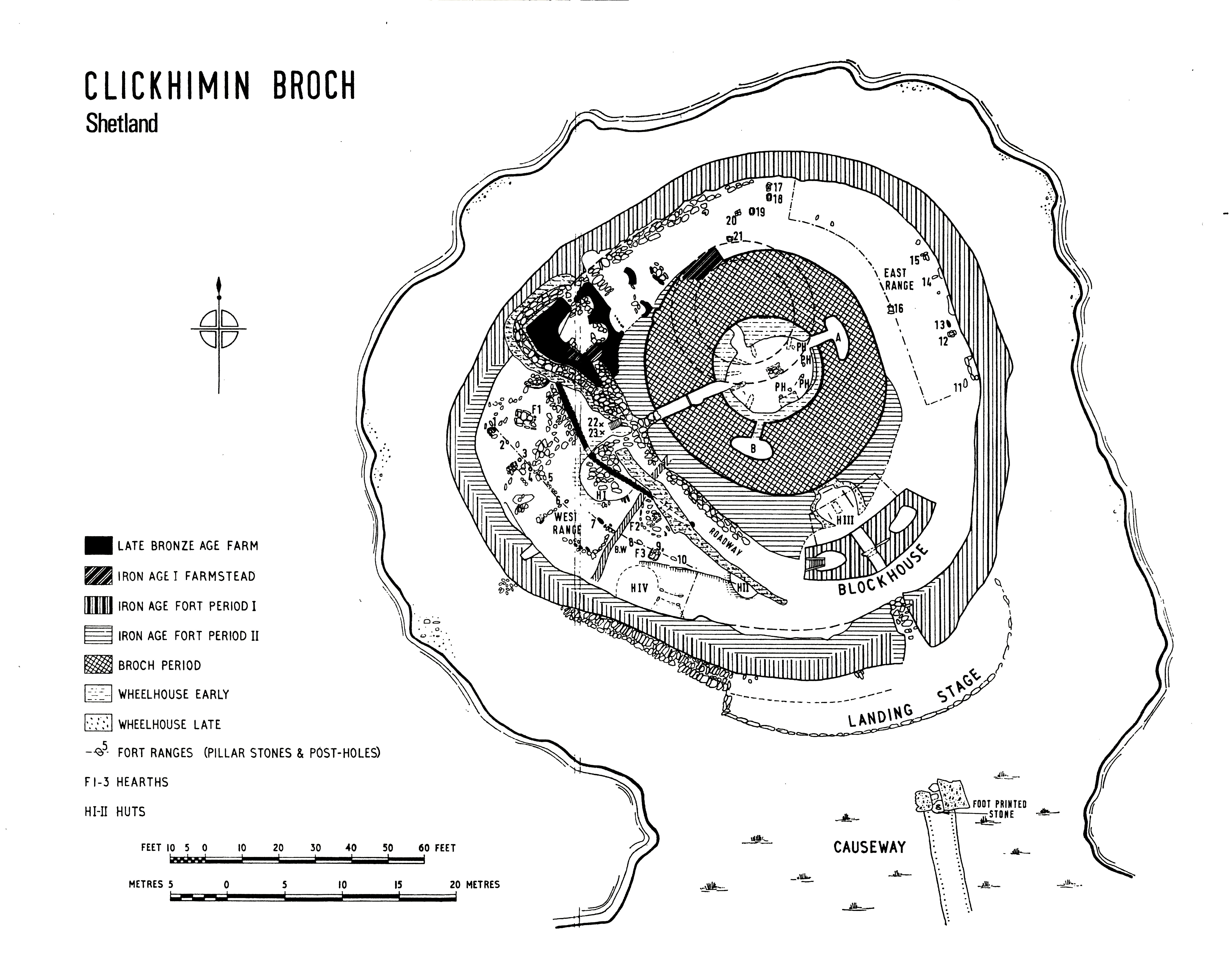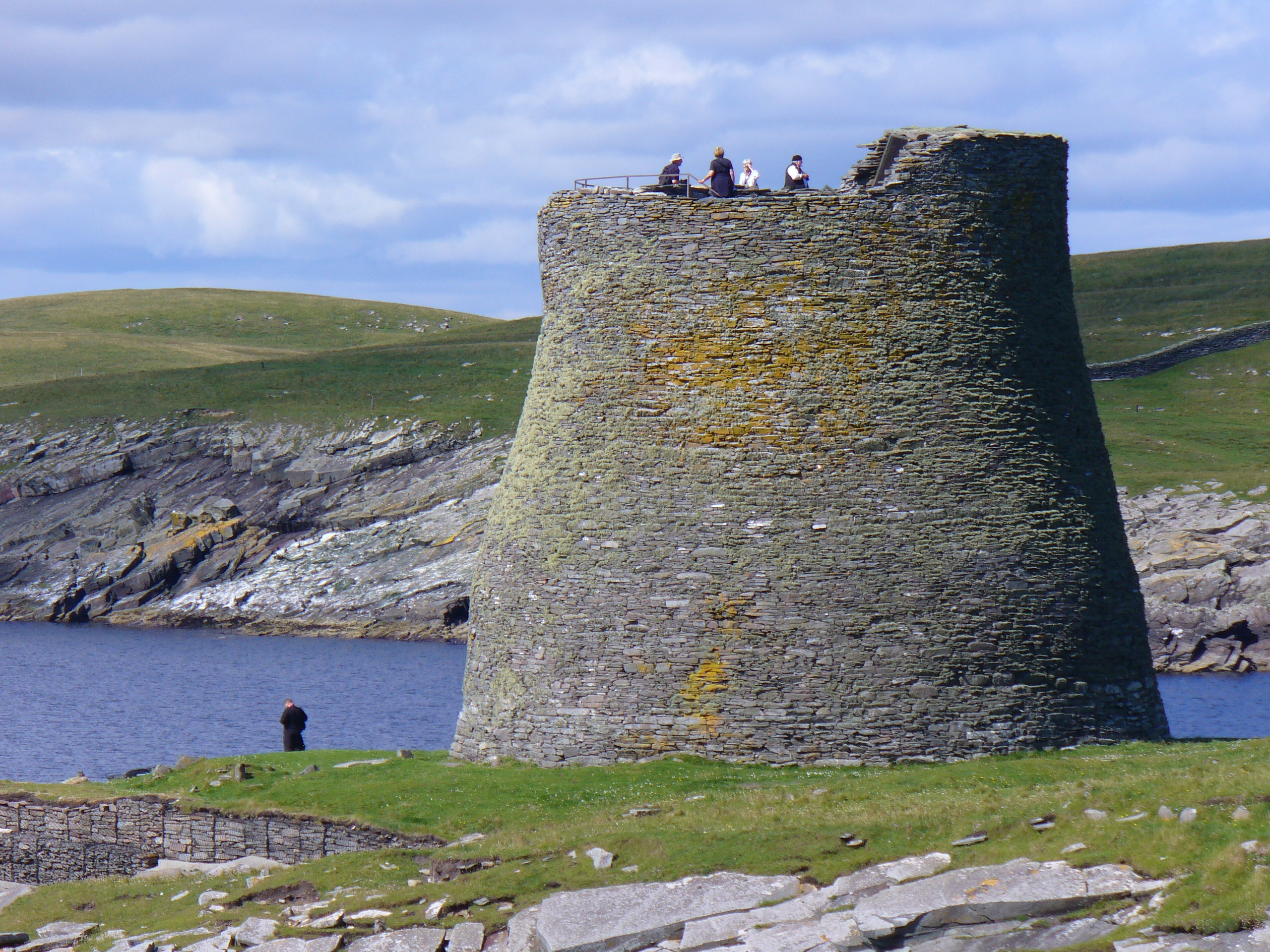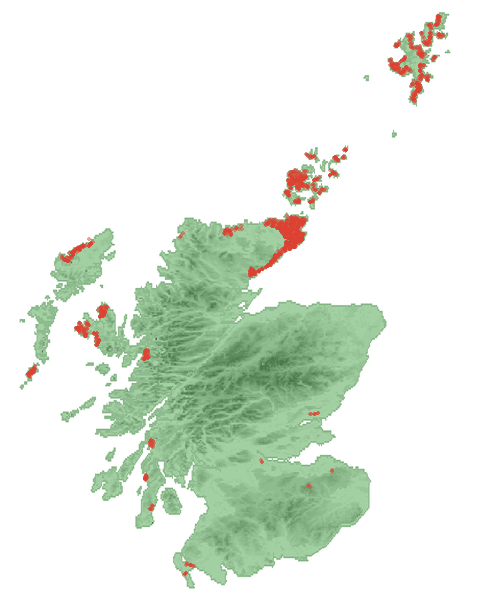|
Broch Of Clickimin
The Broch of Clickimin (also Clickimin or Clickhimin Broch) is a large, well-preserved but restored broch in Lerwick in Shetland, Scotland (). Originally built on an island in Clickimin Loch, it was approached by a stone causeway. The broch is situated within a walled enclosure and, unusually for brochs, features a large "forework" or "blockhouse" between the opening in the enclosure and the broch itself. The site is maintained by Historic Scotland. According to its excavator, John R.C. Hamilton, there were several periods of occupation of the site: Late Bronze Age farmstead, Early Iron Age farmstead, Iron Age fort, broch period, and wheelhouse settlement. Location Clickimin Broch is situated on the south shore of the Clickimin Loch, three-quarters of a mile south-west of Lerwick on the Lerwick-Sumburgh road. It sits on a small promontory jutting into the loch. It is one of the best preserved broch sites in Shetland. Description The broch has an external diameter of around 20 ... [...More Info...] [...Related Items...] OR: [Wikipedia] [Google] [Baidu] |
Mainland, Shetland
The Mainland is the main island of Shetland, Scotland. The island contains Shetland's only burgh, Lerwick, and is the centre of Shetland's ferry and air connections. Geography It has an area of , making it the third-largest Scottish island and the fifth largest of the British Isles after Great Britain, Ireland, Lewis and Harris and Skye. Mainland is the second most populous of the Scottish islands (only surpassed by Lewis and Harris), and had 18,765 residents in 2011 compared to 17,550 in 2001. The mainland can be broadly divided into four sections: *The long southern peninsula, south of Lerwick, has a mixture of moorland and farmland and contains many important archaeological sites. **Bigton, Cunningsburgh, Sandwick, Scalloway, and Sumburgh *The Central Mainland has more farmland and some woodland plantations. *The West Mainland **Aith, Walls, and Sandness *The North Mainland – in particular the large Northmavine peninsula, connected to Mainland by a narrow ist ... [...More Info...] [...Related Items...] OR: [Wikipedia] [Google] [Baidu] |
Broch Of Clickhimin Plan Hamilton 1970
A broch is an Iron Age drystone hollow-walled structure found in Scotland. Brochs belong to the classification "complex Atlantic roundhouse" devised by Scottish archaeologists in the 1980s. Their origin is a matter of some controversy. Origin and definition The word ''broch'' is derived from Lowland Scots 'brough', meaning (among other things) fort. In the mid-19th century Scottish antiquaries called brochs 'burgs', after Old Norse ', with the same meaning. Place names in Scandinavian Scotland such as Burgawater and Burgan show that Old Norse ' is the older word used for these structures in the north. Brochs are often referred to as '' duns'' in the west. Antiquarians began to use the spelling ''broch'' in the 1870s. A precise definition for the word has proved elusive. Brochs are the most spectacular of a complex class of roundhouse buildings found throughout Atlantic Scotland. The Shetland Amenity Trust lists about 120 sites in Shetland as candidate brochs, while the Royal ... [...More Info...] [...Related Items...] OR: [Wikipedia] [Google] [Baidu] |
Historic Scotland Properties In Shetland
History (derived ) is the systematic study and the documentation of the human activity. The time period of event before the invention of writing systems is considered prehistory. "History" is an umbrella term comprising past events as well as the memory, discovery, collection, organization, presentation, and interpretation of these events. Historians seek knowledge of the past using historical sources such as written documents, oral accounts, art and material artifacts, and ecological markers. History is not complete and still has debatable mysteries. History is also an academic discipline which uses narrative to describe, examine, question, and analyze past events, and investigate their patterns of cause and effect. Historians often debate which narrative best explains an event, as well as the significance of different causes and effects. Historians also debate the nature of history as an end in itself, as well as its usefulness to give perspective on the problems of the p ... [...More Info...] [...Related Items...] OR: [Wikipedia] [Google] [Baidu] |
Brochs In Shetland
A broch is an Iron Age drystone hollow-walled structure found in Scotland. Brochs belong to the classification "complex Atlantic roundhouse" devised by Scottish archaeologists in the 1980s. Their origin is a matter of some controversy. Origin and definition The word ''broch'' is derived from Lowland Scots 'brough', meaning (among other things) fort. In the mid-19th century Scottish antiquaries called brochs 'burgs', after Old Norse ', with the same meaning. Place names in Scandinavian Scotland such as Burgawater and Burgan show that Old Norse ' is the older word used for these structures in the north. Brochs are often referred to as '' duns'' in the west. Antiquarians began to use the spelling ''broch'' in the 1870s. A precise definition for the word has proved elusive. Brochs are the most spectacular of a complex class of roundhouse buildings found throughout Atlantic Scotland. The Shetland Amenity Trust lists about 120 sites in Shetland as candidate brochs, while the Royal ... [...More Info...] [...Related Items...] OR: [Wikipedia] [Google] [Baidu] |
Scheduled Ancient Monuments In Shetland
A schedule or a timetable, as a basic time-management tool, consists of a list of times at which possible tasks, events, or actions are intended to take place, or of a sequence of events in the chronological order in which such things are intended to take place. The process of creating a schedule — deciding how to order these tasks and how to commit resources between the variety of possible tasks — is called scheduling,Ofer Zwikael, John Smyrk, ''Project Management for the Creation of Organisational Value'' (2011), p. 196: "The process is called scheduling, the output from which is a timetable of some form". and a person responsible for making a particular schedule may be called a scheduler. Making and following schedules is an ancient human activity. Some scenarios associate this kind of planning with learning life skills. Schedules are necessary, or at least useful, in situations where individuals need to know what time they must be at a specific location to receive a ... [...More Info...] [...Related Items...] OR: [Wikipedia] [Google] [Baidu] |
Clickimin Broch-2-b
The Broch of Clickimin (also Clickimin or Clickhimin Broch) is a large, well-preserved but restored broch in Lerwick in Shetland, Scotland (). Originally built on an island in Clickimin Loch, it was approached by a stone causeway. The broch is situated within a walled enclosure and, unusually for brochs, features a large "forework" or "blockhouse" between the opening in the enclosure and the broch itself. The site is maintained by Historic Scotland. According to its excavator, John R.C. Hamilton, there were several periods of occupation of the site: Late Bronze Age farmstead, Early Iron Age farmstead, Iron Age fort, broch period, and wheelhouse settlement. Location Clickimin Broch is situated on the south shore of the Clickimin Loch, three-quarters of a mile south-west of Lerwick on the Lerwick-Sumburgh road. It sits on a small promontory jutting into the loch. It is one of the best preserved broch sites in Shetland. Description The broch has an external diameter of around 2 ... [...More Info...] [...Related Items...] OR: [Wikipedia] [Google] [Baidu] |
Dice
Dice (singular die or dice) are small, throwable objects with marked sides that can rest in multiple positions. They are used for generating random values, commonly as part of tabletop games, including dice games, board games, role-playing games, and games of chance. A traditional die is a cube with each of its six faces marked with a different number of dots ( pips) from one to six. When thrown or rolled, the die comes to rest showing a random integer from one to six on its upper surface, with each value being equally likely. Dice may also have polyhedral or irregular shapes, may have faces marked with numerals or symbols instead of pips and may have their numbers carved out from the material of the dice instead of marked on it. Loaded dice are designed to favor some results over others for cheating or entertainment. History Dice have been used since before recorded history, and it is uncertain where they originated. It is theorized that dice developed from the pract ... [...More Info...] [...Related Items...] OR: [Wikipedia] [Google] [Baidu] |
Sharpening Stone
Sharpening stones, or whetstones, are used to sharpen the edges of steel tools such as knives through grinding and honing. Such stones come in a wide range of shapes, sizes, and material compositions. They may be flat, for working flat edges, or shaped for more complex edges, such as those associated with some wood carving or woodturning tools. They may be composed of natural quarried material or from man-made material. They come in various grades, which refer to the grit size of the abrasive particles in the stone. (Grit size is given as a number, which indicates the spatial density of the particles; a higher number denotes a higher density and therefore smaller particles, which give a finer finish to the surface of the sharpened object.) Stones intended for use on a workbench are called bench stones, while small, portable ones, whose size makes it hard to draw large blades uniformly over them, especially “in the field,” are called pocket stones. Often whetstones are ... [...More Info...] [...Related Items...] OR: [Wikipedia] [Google] [Baidu] |
Wheelhouse (archaeology)
In archaeology, a wheelhouse is a prehistoric structure from the Iron Age found in Scotland. The term was first coined after the discovery of a ruined mound in 1855. The distinctive architectural form related to the complex roundhouses constitute the main settlement type in the Western Isles in the closing centuries BC. A total of 62 sites have now been identified in the Northern and Western Isles, and on the north coast of Caithness and Sutherland. Amateur enthusiasts did some excavation in the 19th century, but professional examination of the sites did not begin until the 1930s, when digs were undertaken at Jarlshof and Gurness. No work of a modern standard was done in the Hebrides until 1946 at Clettreval on North Uist.Crawford (2002) p. 113. Sometimes referred to as "aisled roundhouses" their characteristic features include an outer wall within which a circle of stone piers (bearing a resemblance to the spokes of a wheel) form the basis for lintel arches supporting corbel ... [...More Info...] [...Related Items...] OR: [Wikipedia] [Google] [Baidu] |
Broch
A broch is an Iron Age drystone hollow-walled structure found in Scotland. Brochs belong to the classification "complex Atlantic roundhouse" devised by Scottish archaeologists in the 1980s. Their origin is a matter of some controversy. Origin and definition The word ''broch'' is derived from Lowland Scots 'brough', meaning (among other things) fort. In the mid-19th century Scottish antiquaries called brochs 'burgs', after Old Norse ', with the same meaning. Place names in Scandinavian Scotland such as Burgawater and Burgan show that Old Norse ' is the older word used for these structures in the north. Brochs are often referred to as '' duns'' in the west. Antiquarians began to use the spelling ''broch'' in the 1870s. A precise definition for the word has proved elusive. Brochs are the most spectacular of a complex class of roundhouse buildings found throughout Atlantic Scotland. The Shetland Amenity Trust lists about 120 sites in Shetland as candidate brochs, while the Roy ... [...More Info...] [...Related Items...] OR: [Wikipedia] [Google] [Baidu] |
Clickimin Loch
Clickimin Loch is a loch in Shetland, Scotland, west of Lerwick Lerwick (; non, Leirvik; nrn, Larvik) is the main town and port of the Shetland archipelago, Scotland. Shetland's only burgh, Lerwick had a population of about 7,000 residents in 2010. Centred off the north coast of the Scottish mainland .... A Pictish fort from the 6th century called Clickimin Broch is located on a small islet at the southern end of the loch. Clickimin Leisure Centre is at the north of the loch. References Lochs of Shetland Lerwick {{Shetland-geo-stub ... [...More Info...] [...Related Items...] OR: [Wikipedia] [Google] [Baidu] |
Shetland
Shetland, also called the Shetland Islands and formerly Zetland, is a subarctic archipelago in Scotland lying between Orkney, the Faroe Islands and Norway. It is the northernmost region of the United Kingdom. The islands lie about to the northeast of Orkney, from mainland Scotland and west of Norway. They form part of the border between the Atlantic Ocean to the west and the North Sea to the east. Their total area is ,Shetland Islands Council (2012) p. 4 and the population totalled 22,920 in 2019. The islands comprise the Shetland constituency of the Scottish Parliament. The local authority, the Shetland Islands Council, is one of the 32 council areas of Scotland. The islands' administrative centre and only burgh is Lerwick, which has been the capital of Shetland since 1708, before which time the capital was Scalloway. The archipelago has an oceanic climate, complex geology, rugged coastline, and many low, rolling hills. The largest island, known as " the Mainland", ... [...More Info...] [...Related Items...] OR: [Wikipedia] [Google] [Baidu] |


.jpg)



.jpg)


